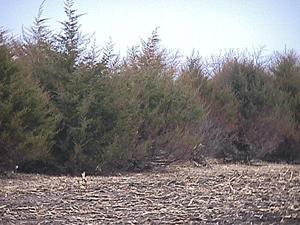Diseases, insects and age have taken a toll on many rural windbreaks throughout Nebraska, resulting in the need renovation or replacement. Older windbreaks may also have crowded or stunted trees. So renovation may entail thinning trees to increase health and vigor or removing rows of dead/dying trees and replanting with new seedlings. Late fall is a good time to step back, and re-evaluate the design, tree selection, and site conditions of your windbreak.
Generally, foresters discourage the removal of entire windbreaks that may be in various stages of decline. Most old windbreaks can be renovated to maintain or enhance their effectiveness in protecting humans, livestock, crops, and buildings, and the locations where the shelterbelts were planted, 25 or more years ago, are generally still the best locations.
Windbreaks are planted to enhance wildlife, provide snow protection for humans and livestock, provide wind protection to dwellings in both winter and summer, prevent soil erosion by wind from farm fields, reduce water runoff from agricultural lands, or provide additional income. When renovating a windbreak, the final re-designed tree stand should meet the objectives determined for your individual site.
Several great University of Nebraska publications are available providing guidance to renovate and re-design your windbreak, getting it back into a healthy condition that provides benefits for years to come. They are available on the Nebraska Extension publications website.
- How Windbreaks Work, EC1763
- Field Windbreaks, EC1778
- Trees of Nebraska, EC1774
- Windbreak Design , G1304
- Windbreak Establishment, G1764
- Windbreak Renovation, EC1777
- Windbreaks and Wildlife, EC1771
- Windbreaks for Fruit and Vegetable Crops, G1779
- Windbreaks for Livestock Operations, EC1776
- Windbreaks for Rural Living, EC1767
- Windbreaks for Snow Management, EC1770
- Windbreaks in Sustainable Agricultural Systems, EC1772
- Windbreak Management, EC1768
- Drip Irrigation Design and Management Considerations for Windbreaks, G1739
- Care of Newly Planted Trees, G1195
Deciding on plant species and purchasing plants is the next critical step in the establishment of a windbreak. This is your best opportunity to avoid plant species susceptible to insect or disease problems. Key points to keep in mind when purchasing tree seedlings include:
- Purchase your stock from a reliable source. Bare-root windbreak tree seedlings are available through your local Natural Resource District office. Now is the time they begin taking orders for windbreak seedlings to be delivery next spring. Locate the NRD office for your area, and look for the Conservation Tree Program.
- Bare-root tree and shrub seedlings can also be purchase from some nurseries. Your seedlings should come from nurseries using locally collected seed or seed from Northern origins. This helps ensure plants that are well adapted to local growing conditions.
- Choose plant material that is suitable for your soils and can survive the environmental extremes of your site.
- Select insect and/or disease resistant plants whenever possible.
- Don't be too quick to buy the cheapest seedlings; they may not be the best value in the long run.
A minimum order of 100 tree or shrub seedlings is required, sold in bundles of 25. You must pick up your tree seedlings when they arrive at the NRD office in spring.
Plant species commonly available through the NRD offices include the following.
- Evergreen trees- Austrian, Eastern White, Southwestern White, Ponderosa and Jack Pine; Eastern Red Cedar; Colorado Blue and Norway Spruce
- Deciduous trees- Bur, Northern Red, and Swamp White Oak; Cottonwood; Black Cherry; Black Walnut; Northern Catalpa; Pecan; and Silver Maple
- Shrubs- American Plum; Hazelnut; Redosier Dogwood; Silver Buffaloberry; Chokecherry; Serviceberry; Elderberry; Common Lilac; Amur Maple; Centennial Cotoneaster; and Skunkbush Sumac
At your request, your local NRD Forester will make a free planning visit to your site, help to design the new windbreak and suggest species of trees best for your site conditions. Many NRD offices also offer, at a minimal cost, additional services associated with tree planting, such as machine planting for large orders.
The quality, size and condition of your tree or shrub seedlings effects plant performance during the establishment period. Look for conifer seedlings that are at least 8 to 12 inches tall, with a good, healthy root system. Use trees that are bare-root or have been grown in a container production system that encourages a dense, fibrous root system such as the Root-maker or grow-bag production systems. Container-grown plants are usually larger and cost more, but may be worth the extra cost in areas where establishment is difficult. Avoid plants that have matted, circling roots.
Usually, for windbreak establishment, quality bare-root stock is satisfactory and cost effective. Bare-root deciduous tree and shrubs seedlings should be 12 to 24 inches tall, with full, healthy root systems, and at least a one-quarter inch diameter just above the root collar (the point where the roots meet the stem). Bare-root seedlings must be handled carefully to ensure good survivability and performance.

